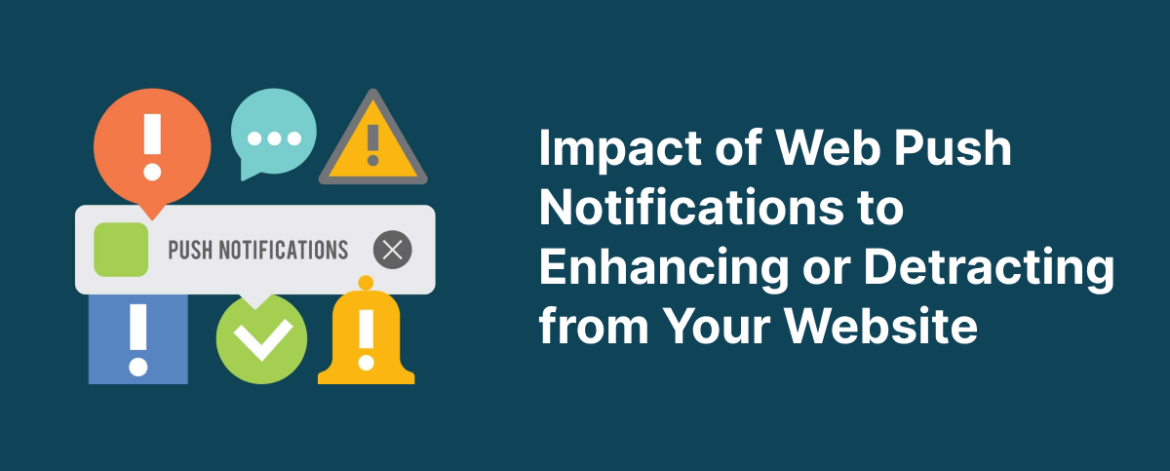In the dynamic digital marketing landscape, the quest for user engagement and retention is ever-evolving. Web push notifications have emerged as a powerful tool, offering direct communication between websites and users. However, the question that looms large is whether these notifications are truly helping or inadvertently harming your site. In this extensive blog post, we delve into the world of web push notifications, dissecting their advantages, and potential pitfalls, and offering actionable insights to ensure optimal implementation on your website.
Section 1: Understanding Web Push Notifications
1.1 Defining Web Push Notifications:
Explore the fundamental concept of web push notifications, understanding how they function and their purpose in fostering real-time communication with users.
Highlight the evolution of web push notifications and their integration across various digital platforms.
1.2 The Mechanics Behind Push Notifications:
Uncover the technical aspects of push notifications, including browser compatibility, notification APIs, and user opt-in mechanisms.
Discuss the role of service workers in enabling push notifications and their impact on website performance.
1.3 Benefits of Web Push Notifications:
Examine the advantages of implementing push notifications, including increased user engagement, timely communication, and enhanced brand recall.
Showcase real-world examples of successful push notification strategies and their positive impact on user retention.
Section 2: Potential Drawbacks and User Experience Considerations
2.1 Notification Fatigue:
Address the phenomenon of notification fatigue, exploring how excessive or irrelevant notifications can lead to user annoyance and opt-out.
Provide insights into best practices for frequency capping and personalized targeting to mitigate notification fatigue.
2.2 Balancing Act: Relevance vs. Intrusiveness:
Analyze the delicate balance between delivering relevant content and avoiding intrusive push notification practices.
Discuss strategies to personalize notifications based on user preferences and behaviors to enhance relevance.
2.3 Opt-In Strategies and Transparency:
Investigate user opt-in strategies, emphasizing the importance of transparent communication regarding the types and frequency of notifications.
Provide examples of effective opt-in prompts and the role of clear, concise messaging in obtaining user consent.
Section 3: Leveraging Push Notifications for Marketing and Engagement
3.1 Personalization and Targeting:
Explore the power of personalization in push notifications, delving into user segmentation, behavioral targeting, and dynamic content delivery.
Showcase case studies illustrating successful personalization strategies that resonate with diverse audience segments.
3.2 Conversion Optimization:
Examine how push notifications can be harnessed for conversion optimization, from abandoned cart reminders to time-sensitive promotions.
Provide actionable tips on crafting compelling call-to-action (CTA) messages that drive user action without being intrusive.
3.3 A/B Testing and Iterative Improvement:
Stress the significance of A/B testing in optimizing push notification strategies, allowing marketers to refine content, timing, and overall effectiveness.
Discuss iterative improvement approaches based on data-driven insights and user feedback.
Section 4: Technical Considerations and Best Practices
4.1 Browser Compatibility and Feature Support:
Provide an overview of browser compatibility for push notifications, highlighting key differences and considerations for various platforms.
Discuss emerging features and standards that impact the implementation of web push notifications.
4.2 Opt-Out Mechanisms and User Control:
Emphasize the importance of providing users with easy-to-use opt-out mechanisms and clear controls over their notification preferences.
Showcase examples of user-friendly notification management interfaces and their impact on user satisfaction.
4.3 Compliance with Privacy Regulations:
Navigate the complex landscape of privacy regulations, such as GDPR and CCPA, and their implications for push notification practices.
Offer a checklist for ensuring compliance and building user trust regarding data handling and privacy concerns.
Section 5: Measuring Success and Analytics
5.1 Key Performance Indicators (KPIs):
Define essential KPIs for evaluating the success of push notification campaigns, including click-through rates, conversion rates, and user retention metrics.
Discuss benchmarks and industry standards to gauge the performance of your push notification strategy.
5.2 Analytics Platforms and Tools:
Explore analytics platforms and tools that provide insights into user behavior, allowing for data-driven decision-making in push notification optimization.
Introduce integration options with popular analytics tools and their role in comprehensive performance analysis.
5.3 Case Studies and Success Stories:
Showcase real-world case studies and success stories of websites that have effectively leveraged push notifications to achieve their marketing and engagement goals.
Extract key takeaways and actionable insights from these examples.
Conclusion:
In conclusion, the impact of web push notifications on your website’s success is a nuanced journey that requires a careful balance between engagement and user experience. By understanding the mechanics, potential drawbacks, and best practices associated with push notifications, you can harness their power to enhance user engagement, drive conversions, and build lasting connections with your audience. This comprehensive analysis serves as a guide for marketers and website owners to navigate the realm of push notifications, ensuring that this powerful tool becomes an asset rather than a detriment to your digital strategy.








